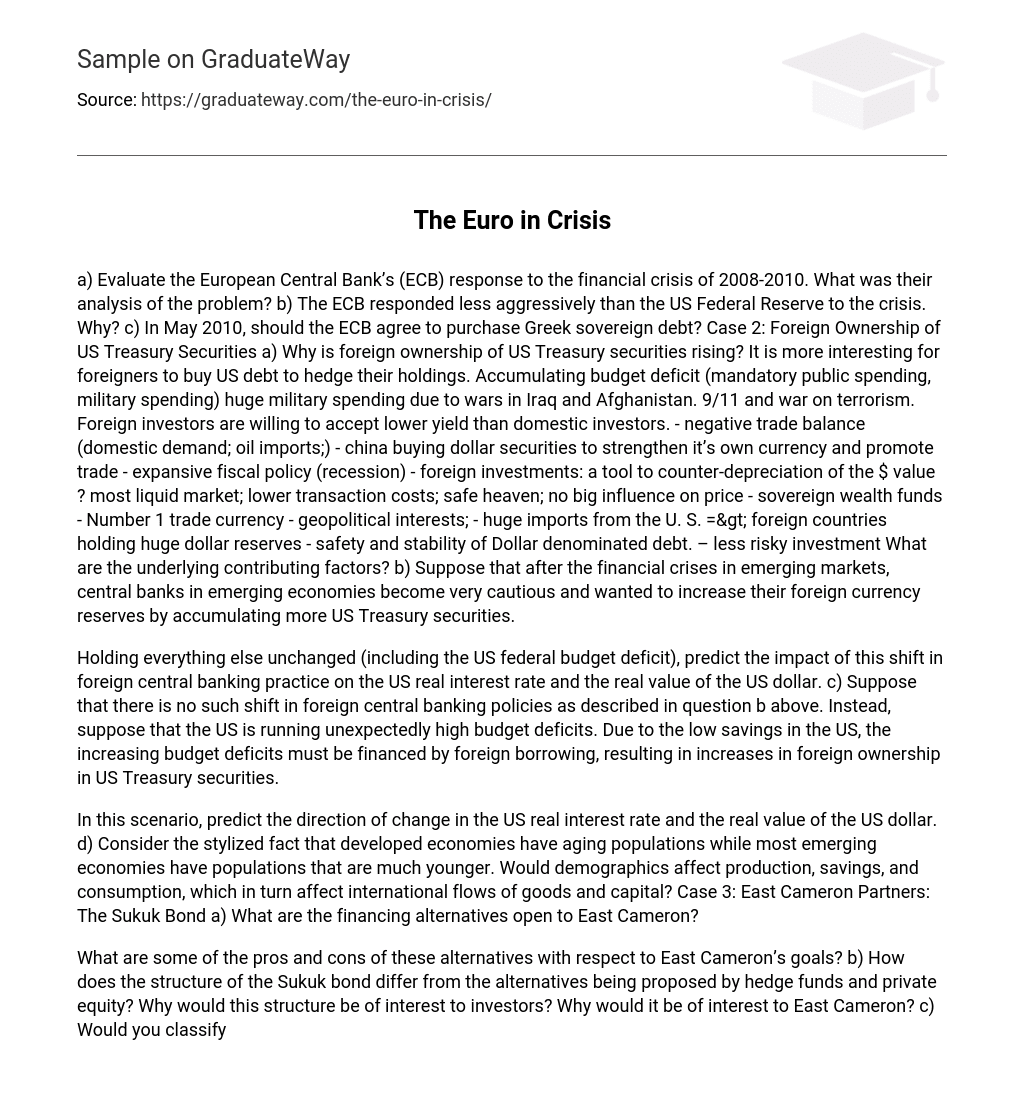The European Central Bank (ECB) conducted an analysis of its response to the financial crisis between 2008 and 2010. The findings revealed that the ECB’s actions were not as forceful as those taken by the US Federal Reserve. The reasons for this discrepancy remain unclear. In addition, there was a question about whether or not the ECB should agree to purchase Greek sovereign debt in May 2010.
Another notable development is the increase in foreign ownership of US Treasury securities. This can be attributed to foreigners finding it more attractive to invest in US debt as a way to protect their investments. Several factors contribute to this trend, including budget deficits, significant military expenditures from engagements in Iraq and Afghanistan, events like 9/11 and efforts against terrorism.
Foreign investors are willing to accept lower yields than domestic investors due to negative trade balances, China’s acquisition of dollar securities for currency strength and trade promotion purposes, expansive fiscal policies during economic downturns, foreign investments serving as protection against depreciation of the US dollar value, market liquidity considerations, and lower transaction costs associated with US Treasury securities being considered a safe haven asset that has minimal impact on prices.
This trend also involves participation from sovereign wealth funds because of the position of the US dollar as the leading currency for international trade.Foreign countries possess significant reserves of US dollars due to geopolitical interests and substantial imports from the United States. In emerging markets, central banks are adopting a cautious approach and giving priority to accumulating US Treasury securities. They view Dollar-denominated debt as a safer and more stable investment, likely influenced by previous financial crises.
If there are no changes in the US federal budget deficit, think about how this change in foreign central banking procedure will impact the US real interest rate and the value of the US dollar. Alternatively, imagine a scenario where the US encounters unforeseen high budget deficits. To finance these growing deficits, external borrowing becomes necessary due to insufficient savings within the US, resulting in an increase in foreign ownership of US Treasury securities.
The prediction of the US real interest rate and the US dollar’s real value is underway, along with an analysis of how demographics impact production, savings, consumption, and global trade in goods and capital. This examination focuses on East Cameron Partners and their financing choices.
What are the advantages and disadvantages of these alternatives in relation to East Cameron’s goals? How does the structure of the Sukuk bond differ from the proposals made by hedge funds and private equity, and why would this structure attract investors? Furthermore, why would East Cameron be interested in it? Is the Sukuk considered as debt or equity, and does this classification matter? In the case of AES, how would you assess their historical capital budgeting method, and what are its strengths and weaknesses? If Venerus implements the suggested methodology, what range of discount rates would AES use globally, and is this a logical approach for capital budgeting? What is the value of the Pakistan project based on the cost of capital derived from the new methodology, and how would this value change if the project was located in the United States? How does the adjusted cost of capital for the Pakistan project reflect the probability of actual events, and what does the adjustment in discount rate imply about expectations for the project in terms of its location in Pakistan instead of the US?
Case 5: Groupe Ariel S. A. – Parity Conditions and Cross-Border Valuation
a) Calculate the net present value (NPV) of Ariel-Mexico’s recycling equipment in pesos by discounting incremental peso cash flows at a peso discount rate. How should this NPV be converted into Euros? Assume an expected future inflation rate of 3% per year in France.
b) Compute the NPV in Euros by converting the project’s future peso cash flows into Euros using expected future spot exchange rates. Keep in mind that Ariel’s Euro hurdle rate for this type of project is 8%. Also, assume annual inflation rates of 7% in Mexico and 3% in France. Compare the two sets of calculations and the corresponding NPVs. How and why do they differ? Which approach should Arnaud Martin use?
d) Should Groupe Ariel approve the purchase of the equipment? Justify your answer.
Case 6: Melco Entertainment – Please note that there is an Excel spreadsheet provided on the portal under the December 7th lecture that will assist with the analysis for this case.
a) Estimate the anticipated cost savings each year resulting from synergies with MGM.
b) Determine the free cash flows that MGM would use to evaluate the company’s equity. How should MGM establish a terminal value?
c) What discount rate should be used to discount the cash flows and terminal value in order to obtain a final value for the company’s equity?d) In Case 7 of Voyages Soleil, the question arises whether it is better to agree to a merger or pursue an IPO. This decision entails weighing the advantages and disadvantages of each option. Furthermore, the company must assess if hedging its transaction risk is necessary and decide between using futures or hedging in the money market. To make an informed decision, it is crucial to carefully consider the benefits and drawbacks of hedging and evaluate alternative methods based on valid reasons.





